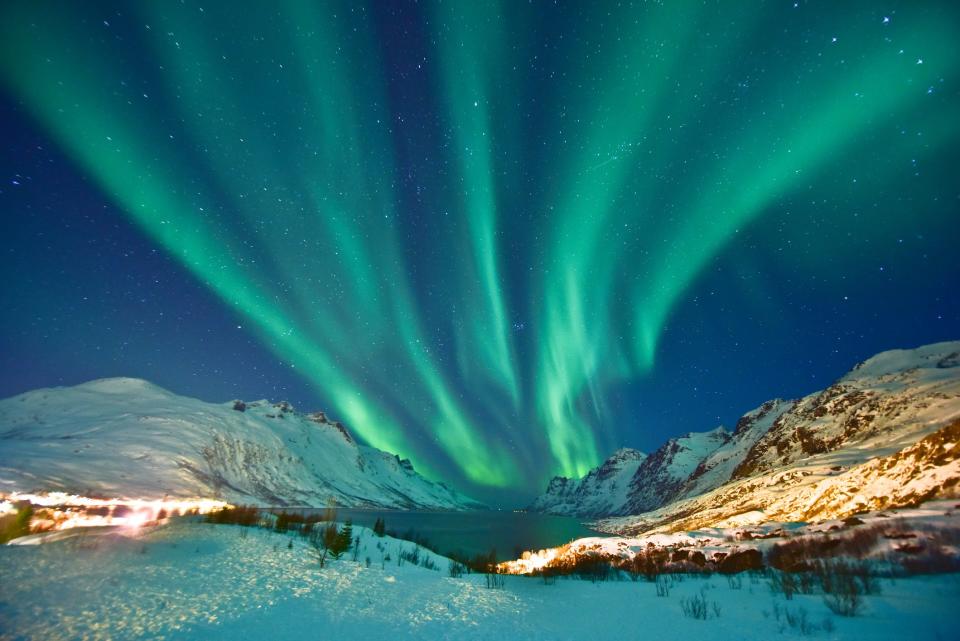After days of optimistic forecasts, northern lights chances are slim. What happened?
Aurora fans, this isn't your week.
Earlier predictions foretold the possibility of a gorgeous display of the northern lights (aka aurora borealis) over as many as 17 states, possibly on Thursday. Now experts say that's unlikely.
What's in the forecast now? "Not much," Bill Murtagh, the program coordinator at the National Oceanic and Atmospheric Administration’s Space Weather Prediction Center, told USA TODAY Wednesday. "This one got blown out of proportion a bit."
The Space Weather Prediction Center's latest aurora forecast, as of midday Thursday, showed no auroral activity expected across the Lower 48 states for Thursday night.
Even in the hours before a northern lights display, it's difficult for forecasters to predict with certainty where the phenomenon will be visible.
AccuWeather meteorologist Brian Lada told USA TODAY "it's easier to make forecasts for Earth-bound weather" than for space weather. He said the best space weather predictions are usually three days out, and that "anything beyond that is just speculation."
Here's why this week's changing forecast attracted more attention than usual.
Long-range forecast attracts national attention
The University of Alaska-Fairbanks' Geophysical Institute made the original forecast last week based on data from NOAA. The university now says that "the high levels of activity previously expected are now considered much less likely."
But before the forecast changed, many news outlets picked up on the long-range aurora forecast, including USA TODAY, which said that states as far south as Maryland could see the famed northern lights on Thursday night.
The Associated Press said that "light displays are expected to be visible overhead in Milwaukee, Minneapolis and Helena, Montana, and low on the horizon in Salem, Oregon; Boise, Idaho; Cheyenne, Wyoming; Annapolis, Maryland; and Indianapolis, according to the institute."
However, what was easy to miss in the long-term prediction: The forecast was based on the 27-day rotation cycle of the sun, and scientists were looking at what happened in previous rotation cycles over the past few months. Based on those observations, some believed the aurora would make an appearance here on Earth on July 13.
That's different than how predictions are made closer to a northern lights event.
Northern lights predictions are 'difficult' even hours before
Most big auroral displays are the result of solar activity such as a solar flare and/or coronal mass ejection (CME). Those ejections can take up to a few days to reach the Earth; thus most predictions of the aurora are usually made only three to four days in advance.
A longer-term auroral forecast, a week or more in advance, anticipates what scientists might see on the surface of the sun when it rotates into view, but a short term forecast, two to three days in advance, waits until they can actually see it.
Unlike terrestrial weather, scientists who forecast space weather – which includes the aurora – must rely on observations of the 93-million-miles-away sun to make their predictions.
"There are so many uncertainties, it makes it difficult to predict," Murtagh said. And as hard as it is to forecast weather here on Earth, "we are decades behind the forecast capabilities of our colleagues in meteorology," he admitted, referring to space weather.

Forecasts a week out are likely to change
Take any space weather forecast that's more than a few days in advance with a grain of salt, experts said. Still, the forecasts for heightened auroral activity this week "took off like wildfire," Lada said, which was "puzzling to me."
The University of Alaska-Fairbanks's Geophysical Institute has been publishing aurora predictions online for 20 years, the university told USA TODAY Thursday. The university also provided a public statement on Tuesday:
"The prediction of active aurora on July 13 was a long-term forecast based on the sun's rotation," the University of Alaska-Fairbanks Geophysical Institute tweeted Tuesday evening. "Looking back one and two solar rotation periods (27 and 54 days) before July 13 showed active conditions prevailed at those times. The features on the sun that produce activity like this typically last 1-3 months, so the active conditions were predicted to occur again this week."
"However, now that the forecast activity is less than three days in the future, we can see that the solar features that produced the prior activity have actually diminished over the last month," the university said.
By midweek, the forecast became rather "underwhelming," Lada said, with "nothing overly dramatic" expected.
Want to see the northern lights?: Good news: Experts predict years of awesome aurora viewing.
Even with a good forecast, weather can block viewing
Terrestrial weather has one direct and very real impact on auroral viewing: Pesky clouds that can obscure the view. Indeed, much of the northern U.S. is looking fairly cloudy over the next couple of nights, Lada said.
This article originally appeared on USA TODAY: Northern lights forecast tonight: No auroral activity in lower 48

